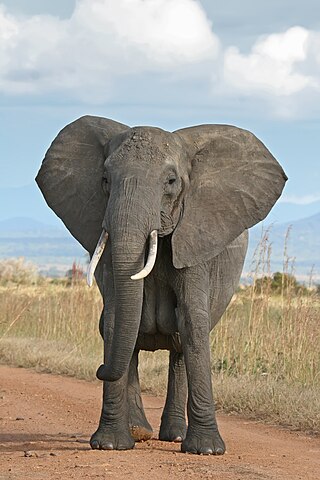
Elephants are the largest living land animals. Three living species are currently recognised: the African bush elephant, the African forest elephant, and the Asian elephant. They are the only surviving members of the family Elephantidae and the order Proboscidea; extinct relatives include mammoths and mastodons. Distinctive features of elephants include a long proboscis called a trunk, tusks, large ear flaps, pillar-like legs, and tough but sensitive grey skin. The trunk is prehensile, bringing food and water to the mouth and grasping objects. Tusks, which are derived from the incisor teeth, serve both as weapons and as tools for moving objects and digging. The large ear flaps assist in maintaining a constant body temperature as well as in communication. African elephants have larger ears and concave backs, whereas Asian elephants have smaller ears and convex or level backs.

A mammoth is any species of the extinct elephantid genus Mammuthus. They lived from the late Miocene epoch into the Holocene until about 4,000 years ago, with mammoth species at various times inhabiting Africa, Europe, Asia, and North America. Mammoths are distinguished from living elephants by their spirally twisted tusks and in at least some later species, the development of numerous adaptions to living in cold environments, including a thick layer of fur.

The coat of arms of South Africa is the main heraldic insignia of South Africa. The present coat of arms was introduced on Freedom Day, 27 April 2000, and was designed by Iaan Bekker. It replaced the earlier national arms, which had been in use since 1910. The motto is written in the extinct ǀXam, member of the Khoisan languages, and translates literally to "diverse people unite". The previous motto, in Latin, was Ex Unitate Vires, translated as "From unity, strength".

The African forest elephant is one of the two living species of African elephant. It is native to humid tropical forests in West Africa and the Congo Basin. It is the smallest of the three living elephant species, reaching a shoulder height of 2.4 m. As with other African elephants, both sexes have straight, down-pointing tusks, which begin to grow once the animals reach 1–3 years old. The forest elephant lives in highly sociable family groups of up to 20 individuals. Since they forage primarily on leaves, seeds, fruit, and tree bark, they have often been referred to as the 'megagardener of the forest'; the species is one of many that contributes significantly to maintaining the composition, diversity and structure of the Guinean Forests of West Africa and the Congolese rainforests. Seeds of various plants will go through the elephant's digestive tract and eventually pass through in the animal's droppings, thus helping to maintain the spread and biodiversity of the forests.

The Houston Zoo is a 55-acre (22 ha) zoological park located within Hermann Park in Houston, Texas, United States. The zoo houses over 6,000 animals from more than 900 species. It receives around 2 million visitors each year and is the second most visited zoo in the United States, surpassed only by the San Diego Zoo. It is accredited by the Association of Zoos and Aquariums (AZA).
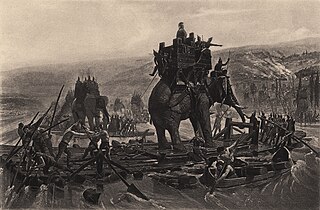
A war elephant was an elephant that was trained and guided by humans for combat. The war elephant's main use was to charge the enemy, break their ranks, and instill terror and fear. Elephantry is a term for specific military units using elephant-mounted troops.
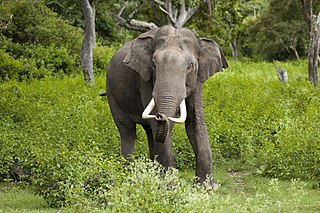
The Asian elephant, also known as the Asiatic elephant, is a species of elephant distributed throughout the Indian subcontinent and Southeast Asia, from India in the west to Borneo in the east, and Nepal in the north to Sumatra in the south. Three subspecies are recognised—E. m. maximus, E. m. indicus and E. m. sumatranus. The Asian elephant is characterised by its long trunk with a single finger-like processing; large tusks in males; laterally folded large ears but smaller in contrast to African elephants; and wrinkled grey skin. The skin is smoother than African elephants and may be depigmented on the trunk, ears or neck. Adult males average 4 tonnes in weight, and females 2.7 t.

African elephants are members of the genus Loxodonta comprising two living elephant species, the African bush elephant and the smaller African forest elephant. Both are social herbivores with grey skin. However, they differ in the size and colour of their tusks as well as the shape and size of their ears and skulls.

Addo Elephant National Park is a diverse wildlife conservation park situated close to Gqeberha in South Africa and is one of the country's 20 national parks. It currently ranks third in size after Kruger National Park and the Kgalagadi Transfrontier Park.

The existence of elephants in ancient China is attested both by archaeological evidence and by depictions in Chinese artwork. Long thought to belong to an extinct subspecies of the Asian elephant named Elephas maximus rubridens, they lived in Central and Southern China before the 14th century BC. They once occurred as far north as Anyang, Henan in Northern China. The elephant is mentioned in the earliest received texts, including the Shijing, Liji, and Zuozhuan. The oracle bone script and bronzeware script glyphs for elephant are pictographic depictions of an animal with a long trunk. Their modern descendant is the regular script character 象.

Charles and George Hurst founded Kenya Breweries Limited in 1922 producing Tusker Lager. The name Tusker came about in memory of George who was trampled to death by a rogue male elephant in 1923.
The Dashabhuja Temple is a Hindu temple in Pune, in the Maharashtra state of India. This temple was once owned by Sardar Haripant Phadke, a Sardar of Peshwa and was later donated to the Peshwas as dowry. Dashabhuja Ganapati temple is visited by thousands of devotees every day and the number increases during Ganesh Chaturthi. The idol of Ganpati or Ganesh seen here has his elephant trunk resting on his right-hand side, which is supposed to be rarer and more sacred than other forms of the Ganesh idol.

Palaeomastodon is an extinct genus within the elephant order Proboscidea. Its fossils have been extracted from Oligocene strata conventionally dated to 33.9-23.03 million years old. Usually considered an ancestor or near-ancestor of elephants or mastodons as a member of Elephantiformes it lived in marshes and fluvial-deltaic environments of what is now Egypt, Ethiopia, Libya, and Saudi Arabia.
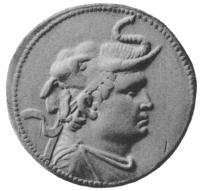
Elephants have been depicted in mythology, symbolism and popular culture. They are both revered in religion and respected for their prowess in war. They also have negative connotations such as being a symbol for an unnecessary burden. Ever since the Stone Age, when elephants were represented by ancient petroglyphs and cave art, they have been portrayed in various forms of art, including pictures, sculptures, music, film, and even architecture.

The African bush elephant, also known as the African savanna elephant, is one of two extant African elephant species and one of three extant elephant species. It is the largest living terrestrial animal, with bulls reaching an average shoulder height of 3.04–3.36 metres (10.0–11.0 ft) and a body mass of 5.2–6.9 tonnes (11,500–15,200 lb), with the largest recorded specimen having a shoulder height of 3.96 metres (13.0 ft) and an estimated body mass of 10.4 tonnes (22,900 lb).
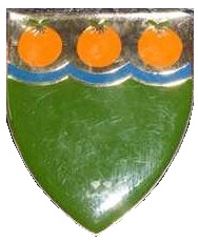
Kirkwood Commando was a light infantry regiment of the South African Army. It formed part of the South African Army Infantry Formation as well as the South African Territorial Reserve.
African-American News and Issues (AANI) is a weekly African-American newspaper published in Houston, Texas. The newspaper is distributed to zip codes that have the largest concentrations of African Americans within the state of Texas. Circulation is estimated at 312,818. It has been described as "Texas' widest circulated and read newspaper with a Black perspective."
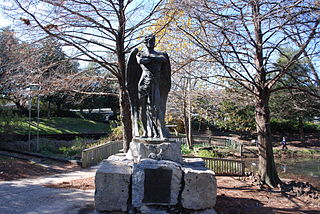
Spirit of the Confederacy, also known as the Confederacy Monument, is an outdoor bronze sculpture depicting an angel holding a sword and palm branch by Louis Amateis, installed in Houston's Sam Houston Park, in the U.S. state of Texas. It was erected in 1908 by a local chapter of the United Daughters of the Confederacy. The statue was removed from the park in 2020 and relocated to the Houston Museum of African American Culture.
An outdoor 1981 bronze sculpture depicting George H. Hermann by Lonnie Edwards is installed in Houston's Hermann Park, in the U.S. state of Texas. The statue, which stands on a pink granite pedestal, was donated by the Hermann Hospital Board of Trustees.

Dhaymoole is an archaeological site in the Sahil province of Somaliland. The site is a cave that contains a collection of ancient rock drawings showing a variety of animals as well as some unidentified symbols. These drawings were created during the third millennium BC.
















